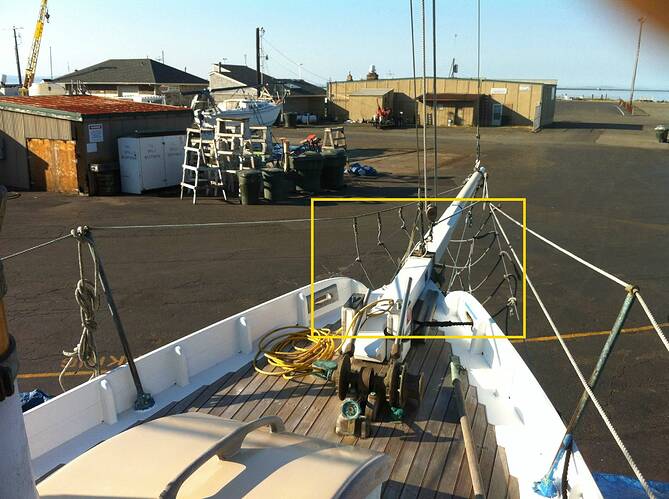Hi,BCC Newbie Matt here again,
Yesterday I stripped the bowsprit with a heat gun and sanded it to let it breath by the stove over night.
This morning I was planning to do some superficial repairs, splining some large screw holes etc when I discovered that the bottom face of the sprit where the cranse-iron fitting was bedded has dryrot.
I have cut out 98% of the rot and it is primarily located in the center plank of the three that compose the turned round end of the bowsprit and of course at the bottom where moisture resides.
If I were to cut a cross section through the sprit, I would say that 25%-35% is gone. It was impossible to detect when the fitting was in place.
The fitting was bedded in what looked like red polysulfide and was a bear to get off, I had to heat it with a torch and pound it off using a block of wood and a brick hammer. When I stripped the caulking it still looked and felt ok but after drying over night, it was obviously soft and so I gouged it out to clean wood with a small chisel.
It is very difficult to know when the wood is solid because fir has such strong fibers, it’s like sisal rope all the fibers remain tough but the pulp wood is gone to hell.
So, how many of you folks have had the fitting off and has anyone had to replace a bowsprit yet?
This would be a particularly difficult sprit to build given its 11.5ft length and the curlicue on the aft end, also turning the forward part would only be possible with a shipyard lathe so sawing it would be the only way I could go.
The top of our sprits are flat while the sides and bottom are tapered so the cranse-iron sits off center at the top so of course turning would be even more challenging, seems like a jig will have to be made to guide a saw.
The cross-mortise at the sampson posts is also difficult without the bigass mortise machine I suppose that they had at the yard.
If I have to build one, does anyone else want one? The set-up for the cuts will be much of the work plus locating the 12ft 1X6’s in vertical grain douglas fir will be challenging based on previous experience.
If I were to build a new one I think I would incorporate a limber hole at the bottom to allow drainage. I think a 1/8" channel running lengthwise and open out the aft bottom end of the cranse-iron.
When installing the cranse-iron I will use a piece of cord in the channel to keep it clear of caulk and pull it out before the bedding sets up so as to leave a clear drain slot. Or at least drill a hole in the fitting and somewhat into the wood.
Anyone got a spare?
Matt
s/v fiddlers green

